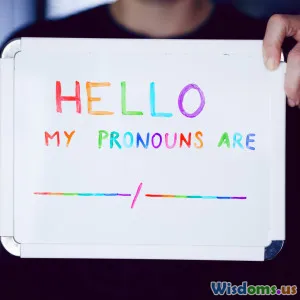
Seven Strategies to Support ESL Students in Any Subject
9 min read Discover seven practical strategies to effectively support ESL students across all subjects, enhancing comprehension and engagement. (0 Reviews)
Seven Strategies to Support ESL Students in Any Subject
Introduction
Educators worldwide face the rewarding challenge of teaching English as a Second Language (ESL) students who bring unique strengths and complex needs into the classroom. With over five million English learners in U.S. public schools alone, representing about 10% of the student population, the ability to support ESL learners is more critical than ever.
Teaching ESL students effectively across subjects—from science to history—requires strategies that promote language acquisition while ensuring content comprehension. Without tailored approaches, these students risk falling behind academically and socially. This article dives into seven practical, research-backed strategies designed to empower educators to support ESL students in any subject, fostering equitable learning environments where language diversity is seen as an asset.
1. Scaffold Instruction with Visual Supports
One of the most effective ways to aid ESL students' comprehension is through scaffolding—breaking lessons into manageable chunks and supporting them with visual aids. Visual supports include graphic organizers, charts, images, videos, and even physical models that provide contextual clues to meaning.
For instance, in a biology class, providing labeled diagrams of the human heart can help ESL students connect vocabulary to visual concepts. A study by Echevarría, Vogt, and Short (2017) on the Sheltered Instruction Observation Protocol (SIOP) model highlights that classrooms using visual scaffolds show significantly improved comprehension among ESL learners.
Benefits of visual supports:
- Reduce cognitive overload by pairing text with images
- Provide context clues that help predict meaning
- Encourage participation and confidence
Teachers can further enhance this by encouraging students to create their own visual notes, reinforcing understanding through kinesthetic and creative learning channels.
2. Use Explicit Language Instruction Across Subjects
While content knowledge is essential, ESL students simultaneously need to develop functional English skills. Incorporating explicit language instruction—teaching vocabulary, academic language, grammar, and language functions—within every subject enhances both language and content mastery.
For example, in a mathematics lesson involving word problems, explicitly teaching key terms like "sum," "difference," and "greater than" aids comprehension and application. Effective practices include:
- Pre-teaching vocabulary before lessons
- Using sentence frames or starters (e.g., "The main idea is…")
- Highlighting linguistic patterns common to the subject
Research by August and Shanahan (2006) underscores that explicit vocabulary instruction positively impacts second-language learners’ understanding and achievement across disciplines.
3. Differentiate Instruction to Meet Diverse Language Proficiencies
ESL students are not a monolith; they arrive with varying levels of English proficiency and educational backgrounds. Differentiating instruction tailors lessons to meet diverse needs and helps all students access the curriculum effectively.
Examples include:
- Providing texts at varying reading levels
- Utilizing bilingual dictionaries or glossaries
- Assigning collaborative work that pairs proficient and emerging English speakers
According to Tomlinson (2014), differentiated instruction not only enhances learning for ESL students but also enriches the classroom dynamics, promoting peer learning and inclusivity.
4. Incorporate Collaborative Learning and Peer Support
Communicative language skills flourish through interaction. Structuring collaborative activities, such as group projects and peer discussions, creates authentic language practice environments.
Real-world example: In a social studies project on local government, groups comprising ESL and native English speakers encourage language development through dialogue, explaining concepts, and negotiating meaning.
Teachers can facilitate this by:
- Assigning roles that require communication (e.g., note-taker, presenter)
- Teaching cooperative learning skills explicitly
- Monitoring and providing feedback on language use during interactions
Vygotsky’s social development theory supports the role of social interaction in language learning, emphasizing that peers can act as Language More Knowledgeable Others (MKOs).
5. Integrate Technology to Enhance Language and Subject Learning
Digital tools have opened versatile avenues to support ESL students. Using language learning apps, interactive content platforms, and multimedia resources caters to auditory, visual, and kinesthetic learning styles.
For example:
- Employing platforms like Google Translate or Microsoft Immersive Reader for immediate language support.
- Using Kahoot! or Quizlet for vocabulary reinforcement through gamified assessment.
- Short, captioned videos that explain complex topics in accessible language.
Data from the EdTech Evidence Exchange (2019) reveals that technology integration significantly accelerates language acquisition and engagement when coupled with pedagogical guidance.
6. Build Cultural Responsiveness and Community Connections
Beyond language, acknowledging students’ cultural backgrounds fosters a respectful and supportive classroom environment. Incorporating cultural responsiveness helps ESL students feel valued, which improves motivation and reduces anxiety.
Practical approaches include:
- Using culturally relevant examples and texts
- Encouraging students to share personal or cultural perspectives related to lesson content
- Engaging families through multilingual communication and school events
According to Geneva Gay, a renowned scholar in culturally responsive teaching, connecting curriculum to students’ cultural experiences deepens learning and identity formation.
7. Regularly Assess and Reflect to Inform Instruction
Continuous assessment tailored to ESL needs provides insight into both language acquisition and content comprehension. Rather than relying solely on standard tests that may challenge ESL students disproportionately, alternative assessment methods include:
- Formative assessments such as exit tickets or concept maps
- Oral presentations and portfolios
- Self-assessment and peer feedback
For example, an ESL learner struggling with a science quiz might better demonstrate understanding through a model or verbal explanation. These varied methods provide teachers with comprehensive data to adapt teaching strategies.
Moreover, reflective practice enables educators to evaluate the effectiveness of their approaches and seek professional development accordingly. As Education Week notes, success in ESL instruction requires iterative adjustments informed by student outcomes and feedback.
Conclusion
Supporting ESL students across subjects demands intentional, research-based approaches combining language development with content delivery. Implementing scaffolding, explicit language instruction, differentiation, collaboration, technology, cultural responsiveness, and thoughtful assessment creates inclusive learning opportunities where ESL students thrive. Educators equipped with these strategies not only bridge linguistic gaps but also celebrate diversity as a cornerstone of academic enrichment.
By embracing these seven strategies, teachers can foster classrooms that nurture confidence, curiosity, and competence for ESL learners—empowering them to succeed, no matter the subject or setting.
References:
- August, D., & Shanahan, T. (Eds.). (2006). Developing Literacy in Second-Language Learners: Report of the National Literacy Panel on Language-Minority Children and Youth. Routledge.
- Echevarría, J., Vogt, M., & Short, D. (2017). Making Content Comprehensible for English Learners: The SIOP Model. Pearson.
- Gay, G. (2018). Culturally Responsive Teaching: Theory, Research, and Practice. Teachers College Press.
- Tomlinson, C. A. (2014). The Differentiated Classroom: Responding to the Needs of All Learners. ASCD.
- Vygotsky, L. S. (1978). Mind in Society: The Development of Higher Psychological Processes. Harvard University Press.
- EdTech Evidence Exchange. (2019). "Impact of Technology on ESL Students’ Learning." Retrieved from https://edtechevidence.org
- Education Week. (2020). "Assessing English Language Learners: Strategies for Inclusion."
Rate the Post
User Reviews
Other posts in Cultural Diversity in Education
Popular Posts

















